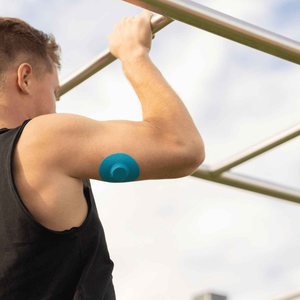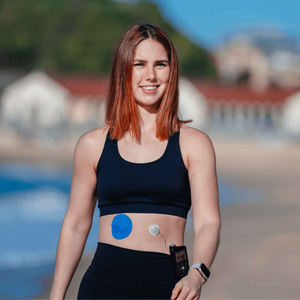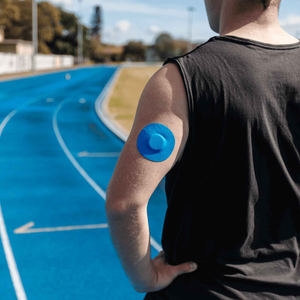It is a sobering fact that almost half of people living with diabetes do not know they have it. The International Diabetes Federation (IDF) reports that 44.7% of adults aged 20-79 with diabetes were undiagnosed in 2021 (Ogurtsova et al. 2022). That means millions are at risk of complications without even being aware they need treatment.
If you live with diabetes, or worry you may be at risk, this statistic can feel overwhelming. But it is also an opportunity. The earlier diabetes is detected, the earlier you can act – and with modern tools like continuous glucose monitoring (CGM), recognising warning signs is more possible than ever.
Disclaimer: This article is for education only. Always consult your healthcare professional for testing, diagnosis, and treatment advice.
Why so many people remain undiagnosed
Diabetes can develop gradually, and for many, the symptoms are either invisible or dismissed as part of “normal life.” Fatigue, increased thirst, or frequent urination might be attributed to ageing, stress, or a busy lifestyle. Yet these are often early signs of diabetes.
The barriers to diagnosis are complex and include:
- Subtle onset of type 2 diabetes – Unlike type 1, which often develops rapidly, type 2 diabetes can progress over years with few obvious symptoms.
- Healthcare access – People in rural or low-resource settings may not have routine blood sugar screening.
- Sociocultural factors – In some cultures, symptoms may be normalised or health care delayed until complications appear.
- Low awareness – Many do not realise that being overweight, inactive, or having a family history significantly raises their risk.
A global analysis found that even in countries with strong healthcare systems, between 17% and 33% of people with diabetes are undiagnosed (Fang et al. 2022).
Signs and risk factors you should not ignore
While only a blood test can confirm diabetes, there are warning signs you should pay attention to.
|
Early signs of diabetes |
Why it happens |
|
Persistent tiredness |
Glucose is not entering cells effectively, leaving you low on energy |
|
Increased thirst and urination |
The kidneys attempt to remove excess glucose from the blood |
|
Blurred vision |
High glucose temporarily changes fluid balance in the eye lens |
|
Slow-healing cuts or infections |
Diabetes affects circulation and immune function |
|
Tingling or numbness in hands/feet |
Nerve endings can be affected early on |
Risk factors also increase the likelihood: a family history of diabetes, overweight, sedentary lifestyle, and age over 40. People from certain ethnic backgrounds also face higher risks, according to the IDF Diabetes Atlas.
If these resonate with you, it may be time to ask your doctor for a test.

How widespread is undiagnosed diabetes?
|
Region |
Estimated undiagnosed rate |
Source |
|
Global (20-79 yrs) |
~44.7% |
Ogurtsova et al. 2022 |
|
Europe |
~36% |
IDF Atlas factsheet |
|
USA |
17-33% |
Fang et al. 2022 |
|
Western Pacific (includes Australia) |
50%+ in some populations |
IDF Diabetes Atlas |
This makes clear that undiagnosed diabetes is a global challenge. Even where awareness is higher, a large group of people remain unaware of their condition.
How CGMs are changing early awareness
Traditionally, blood glucose was only checked during routine appointments or finger-prick testing. This meant long gaps between readings – and many people went undiagnosed until complications appeared.
A continuous glucose monitor tracks glucose 24/7, showing you trends and responses to meals, exercise, and stress. For someone at risk, this can reveal spikes that might otherwise go unnoticed.
But sensors are only useful if they stay in place securely. Many new users find their sensors peel off with sweat, water, or daily activity. This is where CGM patches become essential. They protect your sensor so the data you rely on is accurate.
- For new Dexcom users, Dexcom G7 patches keep sensors stable during workouts.
- For families using Medtronic, Guardian patches prevent edge-lifting at school or work.
- For Freestyle Libre, Libre patches extend wear during swimming or daily routines.
To find what suits your skin best, a patch and wipes bundle lets you test combinations. Pairing patches with adhesive wipes can also reduce irritation and improve wear time.
People also ask
How common is undiagnosed diabetes?
Globally, almost half of adults with diabetes are undiagnosed (Ogurtsova et al. 2022).
What happens if diabetes goes untreated?
Without diagnosis and treatment, high glucose can damage nerves, kidneys, eyes, and the heart. Many of these complications are preventable with early care.
Can you detect diabetes with a CGM?
A CGM is not a diagnostic tool, but unusual patterns – like consistently high glucose after meals – are a reason to seek formal testing.
What is the first step if I suspect diabetes?
Ask your GP about a blood test such as fasting glucose, HbA1c, or an oral glucose tolerance test. These confirm diagnosis and guide treatment.
Can lifestyle changes reduce risk before diagnosis?
Yes. Even if you are only at risk, increasing activity, eating balanced meals, and managing weight can reduce your chance of developing type 2 diabetes (IDF 2021).
Internal links for CGM users
If you already use CGM technology, supporting it properly can make the data more reliable. These guides will help:
- Proper skin prep improves adhesion.
- How long a CGM patch lasts helps set realistic expectations.
- Signs your patch is too weak can prevent failed readings.
Taking control starts with awareness
The fact that nearly half of people with diabetes do not know it underlines the importance of awareness. But it is also a reminder that you are not powerless. By learning the signs, arranging regular check-ups, and using CGM technology with the right patches, you can act early and confidently.

At Type Strong, we believe your CGM should be a tool for empowerment, not worry. With Dexcom patches, Omnipod patches, or tape rolls for extra customisation, you can keep your sensor secure and focus on what matters – living life well.
References
- Ogurtsova K, da Rocha Fernandes JD, Huang Y, et al. (2022). Global estimates of undiagnosed diabetes in adults for 2021. Diabetes Research and Clinical Practice 183: 109118.
- International Diabetes Federation (2021). IDF Diabetes Atlas, 10th edition. Brussels: IDF.
- Fang M, Wang D, Pan Q, et al. (2022). Undiagnosed diabetes in U.S. adults: prevalence and trends 1988–1994 through 2017–March 2020. Diabetes Care 45(10): 2287-2295.





